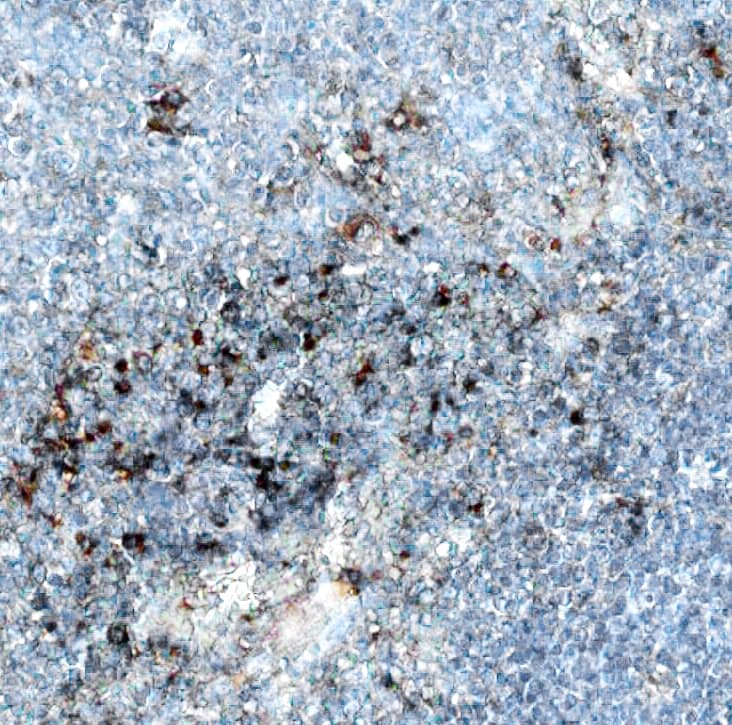Human CD40 Ligand/TNFSF5 Antibody
R&D Systems, part of Bio-Techne | Catalog # MAB617


Conjugate
Catalog #
Key Product Details
Species Reactivity
Validated:
Human
Cited:
Human
Applications
Validated:
Blockade of Receptor-ligand Interaction, CyTOF-ready, Flow Cytometry, Immunohistochemistry, Western Blot
Cited:
Bioassay, Blocking, Immunohistochemistry, Neutralization
Label
Unconjugated
Antibody Source
Monoclonal Mouse IgG2B Clone # 40804
Product Specifications
Immunogen
E. coli-derived recombinant human CD40 Ligand/TNFSF5
Leu50-Leu261
Accession # P29965
Leu50-Leu261
Accession # P29965
Specificity
Detects human CD40 Ligand/TNFSF5 in direct ELISAs and Western blots. In direct ELISAs and Western blots, no cross-reactivity with recombinant human (rh) CD27 Ligand, rhCD30 Ligand, or recombinant mouse CD40 Ligand is observed.
Clonality
Monoclonal
Host
Mouse
Isotype
IgG2B
Endotoxin Level
<0.10 EU per 1 μg of the antibody by the LAL method.
Scientific Data Images for Human CD40 Ligand/TNFSF5 Antibody
CD40 Ligand/TNFSF5 in Human Tonsil.
CD40 Ligand/TNFSF5 was detected in immersion fixed paraffin-embedded sections of human tonsil using Mouse Anti-Human CD40 Ligand/TNFSF5 Monoclonal Antibody (Catalog # MAB617) at 15 µg/mL overnight at 4 °C. Tissue was stained using the Anti-Mouse HRP-DAB Cell & Tissue Staining Kit (brown; Catalog # CTS002) and counterstained with hematoxylin (blue). Specific staining was localized to lymphocytes. View our protocol for Chromogenic IHC Staining of Paraffin-embedded Tissue Sections.Applications for Human CD40 Ligand/TNFSF5 Antibody
Application
Recommended Usage
Blockade of Receptor-ligand Interaction
In a functional ELISA, 0.03-0.1 µg/mL of this antibody will block 50% of the binding of 2 ng/mL of biotinylated Recombinant Human CD40 Ligand to immobilized Recombinant Human CD40/TNFRSF5 Fc Chimera (Catalog # 1493‑CD) coated at 2 µg/mL (100 µL/well). At 1 μg/mL, this antibody will block >90% of the binding.
CyTOF-ready
Ready to be labeled using established conjugation methods. No BSA or other carrier proteins that could interfere with conjugation.
Flow Cytometry
0.25 µg/106 cells
Sample: Human peripheral blood mononuclear cells treated with PMA and Ca2+ ionomycin
Sample: Human peripheral blood mononuclear cells treated with PMA and Ca2+ ionomycin
Immunohistochemistry
8-25 µg/mL
Sample: Immersion fixed paraffin-embedded sections of human tonsil
Sample: Immersion fixed paraffin-embedded sections of human tonsil
Western Blot
1 µg/mL
Sample: Recombinant Human CD40 Ligand/TNFSF5 aa 108-261 (Catalog # 6245-CL)
Sample: Recombinant Human CD40 Ligand/TNFSF5 aa 108-261 (Catalog # 6245-CL)
Reviewed Applications
Read 1 review rated 3 using MAB617 in the following applications:
Formulation, Preparation, and Storage
Purification
Protein A or G purified from hybridoma culture supernatant
Reconstitution
Reconstitute at 0.5 mg/mL in sterile PBS. For liquid material, refer to CoA for concentration.
Formulation
Lyophilized from a 0.2 μm filtered solution in PBS with Trehalose. *Small pack size (SP) is supplied either lyophilized or as a 0.2 µm filtered solution in PBS.
Shipping
Lyophilized product is shipped at ambient temperature. Liquid small pack size (-SP) is shipped with polar packs. Upon receipt, store immediately at the temperature recommended below.
Stability & Storage
Use a manual defrost freezer and avoid repeated freeze-thaw cycles.
- 12 months from date of receipt, -20 to -70 °C as supplied.
- 1 month, 2 to 8 °C under sterile conditions after reconstitution.
- 6 months, -20 to -70 °C under sterile conditions after reconstitution.
Background: CD40 Ligand/TNFSF5
References
- Zhang, G. (2004) Curr. Opin. Struct. Biol. 14:154.
- Hehlgans, T. and K. Pfeffer (2005) Immunology 115:1.
- Quezada, S.A. et al. (2004) Annu. Rev. Immunol. 22:307.
- Graf, D. et al. (1992) Eur. J. Immunol. 22:3191.
- Hollenbaugh, D. et al. (1992) EMBO J. 11:4313.
- Khandekar, S.S. et al. (2001) Prot. Exp. Purif. 23:301.
- Pietravalle, F. et al. (1996) J. Biol. Chem. 271:5965.
- Garber, E. et al. (1999) J. Biol. Chem. 274:33545.
- Vakkalanka, R.K. et al. (1999) Arthritis Rheum. 42:871.
- Eissner, G. et al. (2004) Cytokine Growth Factor Rev. 15:353.
- Prasad, K.S. et al. (2003) Proc. Natl. Acad. Sci. USA 100:12367.
- Mikolajczak, S.A. et al. (2004) J. Exp. Med. 199:1025.
- Lievens, D. et al. (2009) Thromb. Haemost. 102:206.
- Elgueta, R. et al. (2009) Immunol. Rev. 229:152.
- Avery, D.T. et al. (2008) J. Immunol. 181:1767.
Alternate Names
CD154, CD40L, CD40LG, gp39, TNFSF5, TRAP
Gene Symbol
CD40LG
UniProt
Additional CD40 Ligand/TNFSF5 Products
- All Products for CD40 Ligand/TNFSF5
- CD40 Ligand/TNFSF5 cDNA Clones
- CD40 Ligand/TNFSF5 ELISA Kits
- CD40 Ligand/TNFSF5 Luminex Assays
- CD40 Ligand/TNFSF5 Lysates
- CD40 Ligand/TNFSF5 Primary Antibodies
- CD40 Ligand/TNFSF5 Proteins and Enzymes
- CD40 Ligand/TNFSF5 Simple Plex
- CD40 Ligand/TNFSF5 Small Molecules and Peptides
Product Documents for Human CD40 Ligand/TNFSF5 Antibody
Product Specific Notices for Human CD40 Ligand/TNFSF5 Antibody
For research use only
